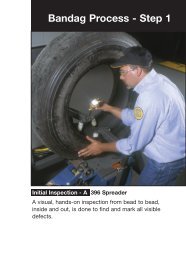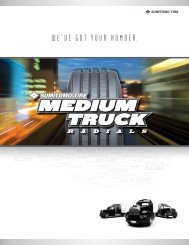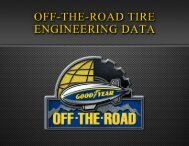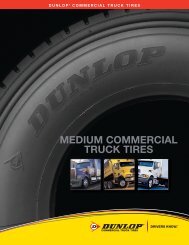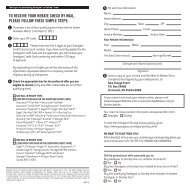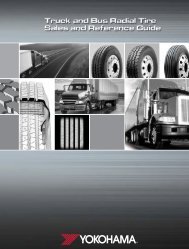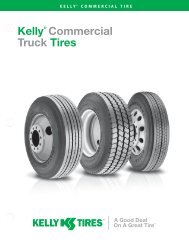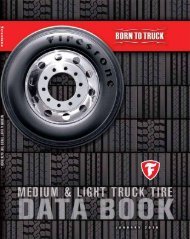Bridgestone Medium and Light Truck Tire Data Book - Sullivan Tire ...
Bridgestone Medium and Light Truck Tire Data Book - Sullivan Tire ...
Bridgestone Medium and Light Truck Tire Data Book - Sullivan Tire ...
You also want an ePaper? Increase the reach of your titles
YUMPU automatically turns print PDFs into web optimized ePapers that Google loves.
Effective January 2010<br />
Mounting<br />
Tube-type<br />
• Remove the tube <strong>and</strong> flap from the tire (if<br />
installed). Clean <strong>and</strong> dry the inside of the tire to<br />
ensure that all moisture, dirt <strong>and</strong> foreign material<br />
is removed prior to mounting.<br />
• Install the proper size tube <strong>and</strong> flap. Always install<br />
new <strong>Bridgestone</strong> radial tubes <strong>and</strong> radial flaps<br />
in new <strong>Bridgestone</strong> radial tires. Be sure tubes<br />
marked “radial” are used in radial tires. Place the<br />
tube inside the tire <strong>and</strong> install the flap, ensuring<br />
that the flap is centered. Slightly inflate the tube<br />
enough to shape it out.<br />
• Lubricate the beads, rim side of the flap <strong>and</strong> the<br />
tube base with a vegetable-based lubricant. Do<br />
not over-lubricate (inside of tire must stay dry).<br />
• Mount the tire, tube <strong>and</strong> flap assembly on the rim.<br />
• Assemble the rim parts making sure<br />
proper components are used <strong>and</strong> a proper<br />
fit is established.<br />
• When inflating, always place the tire in an<br />
approved safety cage or equivalent<br />
restraining device <strong>and</strong> use an extension hose<br />
<strong>and</strong> clip-on chuck.<br />
• Never st<strong>and</strong> over a tire while inflating. Do not<br />
attempt to seat rim components by tapping with a<br />
mallet when tire is inflated.<br />
Tubeless<br />
• Clean <strong>and</strong> prepare rim or wheel.<br />
• Replace valve seals <strong>and</strong> stem.<br />
• Lubricate both beads <strong>and</strong> both rim flanges.<br />
• Work the tire over the rim flanges using proper<br />
tubeless tire tools.<br />
• Mount the tire over the valve side.<br />
• Inflate tire in safety cage to seat beads.<br />
• Do not exceed the maximum inflation pressures<br />
shown on tire sidewall/rim.<br />
WARNING: When mounting truck tires, never<br />
use pressures above 40 psi to seat tire beads. If beads<br />
have not seated by the time pressure reaches 40 psi,<br />
deflate the assembly, reposition the tire on the rim,<br />
re-lubricate tire beads, rim humps, bead seat,<br />
<strong>and</strong> re-inflate.<br />
Cautions<br />
General Technical Information<br />
Always inflate tire/rim assembly in an approved safety<br />
cage or equivalent restraining device, use remote<br />
controlled clip-on air hose, <strong>and</strong> inflate to pressure<br />
recommended by vehicle manufacturer.<br />
Always ensure that rim components fit properly<br />
before inflating.<br />
Never tap component parts with a mallet while the<br />
tire is inflated.<br />
Never attempt to disassemble multi-piece rims<br />
while inflated.<br />
Do not exceed the maximum inflation pressure on<br />
the sidewall of the tire. If beads do not seat at 40 psi,<br />
deflate, re-lubricate <strong>and</strong> re-inflate.<br />
WARNING: Never pour or spray any flammable<br />
substance into or onto a tire or wheel for any<br />
purpose whatsoever. The residue left by the<br />
substance could result in a fire or explosion, which<br />
could cause an accident.<br />
WARNING: Never pour or spray a flammable<br />
substance such as gasoline or ethyl ether into a tire<br />
<strong>and</strong> light with a match so that the resulting explosion<br />
seats the beads of a tubeless tire. This practice is<br />
extremely dangerous <strong>and</strong> can result in a severe<br />
explosion or undetected damage to the tire or rim<br />
which can cause severe injury or death.<br />
WARNING: Always replace a tire on a rim with<br />
another tire of exactly the same bead diameter as the<br />
diameter of the rim on which it will be mounted.<br />
Correct Rim Selection<br />
<strong>Bridgestone</strong> tires are designed to be used on wheels<br />
<strong>and</strong> rims that conform to the dimensions <strong>and</strong> contours<br />
shown in the <strong>Tire</strong> <strong>and</strong> Rim Association Yearbook for<br />
the year in which the tire is manufactured <strong>and</strong> that<br />
are designed as approved wheels <strong>and</strong> rims for each<br />
particular tire size <strong>and</strong> type.<br />
Usage of other wheels <strong>and</strong> rims must be expressly<br />
approved by <strong>Bridgestone</strong> Firestone North American<br />
<strong>Tire</strong>, LLC for the particular application involved.<br />
The load <strong>and</strong> cold inflation pressure must not exceed<br />
the rim <strong>and</strong> wheel manufacturer’s recommendations<br />
even though the tire may be approved for a higher<br />
load or inflation.<br />
Rims <strong>and</strong> wheels may be identified (stamped) with a<br />
maximum load <strong>and</strong> maximum cold inflation rating.<br />
For rims <strong>and</strong> wheels not so identified or for service<br />
conditions exceeding the rated capacities, consult the<br />
rim <strong>and</strong> wheel manufacturer to determine rim <strong>and</strong><br />
wheel capacities for the intended service.<br />
<strong>Medium</strong> <strong>Truck</strong> <strong>Light</strong> <strong>Truck</strong> General Technical Load/Inflation Technical Bulletins<br />
81



